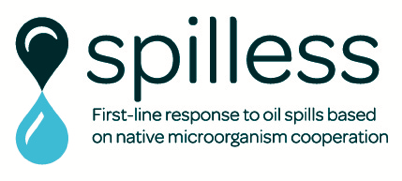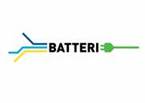SpilLess- First-line response to oil spills based on native microorganism cooperation
SpilLess aims to develop and implement new and viable solutions to tackle one of the most damaging sources of maritime pollution: oil spills. These solutions will be marketable services and products based on the production of native microbial consortia with bioremediation capacity and on the adaptation of unmanned autonomous vehicles for in-situ contamination combat. By combining biotechnology with robotics, SpilLess pretends to create a novel approach that can be used as a first-line response to pollution incidents in a fast, efficient and low-cost way.
Marine oil spills are catastrophic events that lead to high losses of marine life and ecosystems. Oil spill incidents occur regularly during the exploration, production, refining, transport and storage of petroleum and petroleum products. In recent years, several oil spill disasters have occurred, with Deepwater Horizon (2010) being considered one of the larger accidental marine oil spill in the history of the petroleum industry, leading to the spill of over 500.000 tons of crude oil, at the Gulf of México. In the last 50 years, several major spills occurred in the NW Iberian Peninsula, one of the main routes of oil cargo in Europe, as a result of tanker accidents. In 1975, the oil tanker Jakob Maersk, which was loaded with 80.000 tons of heavy crude oil and 4.000 tons of heavy fuel, hit a sandbank while entering the sea harbour of Leixões (Porto, North of Portugal) and ended up exploding and breaking apart. As a result, around 50.000 tons of oil were consumed by fire, 25.000 tons were drifted at sea and 15.000 tons came to shore. More recently, in 2002, the oil tanker Prestige sank at 250 km from the coast of Galicia (North of Spain) spilling more than 60.000 tons of crude oil, polluting thousands of kilometres of coastline and causing great harm to the local fishing industry. This was considered one of the larger environmental disasters in the history of Iberian Peninsula. Jakob Maersk and Prestige cases occupy the 13th and 20th position, respectively, at the ranking of the worldwide major oil spills (ITOF 2015).
The occurrence of such incidents requires immediate, simple, effective and eco-friendly actions to minimize environmental damages. First-line responses typically include physical (e.g., controlled burning; absorbing) and chemical (e.g., dispersing) removal of oil, which is largely constrained by maritime conditions. Though these treatments are important to rapidly control the diffusion and drift of the oil, they are not suitable for ecological restoration. Recently, bioremediation using microorganisms to degrade the remaining spilled oil has been proposed as a cost-effective alternative to the use of chemical additives. The use of microorganisms with a natural capacity to degrade petroleum is highly advantageous in that it is an environmentally friendly process and allows complete decomposition of complex petroleum hydrocarbons. The efficient biodegradation of oil spills requires a jointed action of a consortium of microorganisms, i.e., a group of diverse microbial species with a complementary range of metabolic capabilities, rather than the action of individual microbial species.
The overall aim of the SpilLess project is the implementation of an innovative “laboratory” (Blue Lab) to pilot new and viable solutions to tackle with maritime pollution (in particular, oil spills). These solutions will be based on the production of native microbial consortiawith bioremediation capacity, and the adaptation of unmanned and autonomous vehicles for in-situ release of autochthonous microorganisms (bioaugmentation) and nutrients (biostimulation). By doing so, these systems can be used as first line responders to pollution incidents in a fast, efficient and low cost way. Such innovative solutions aim to:
- be environment-friendly, by using native organisms to naturally degrade oil spills, and thus avoiding the introduction of additional chemical or biological additives;
- integrate first line responses to oil spill incidents, by using unmanned and autonomous vehicles, which are able to operate under unfavourable and harsh conditions with low human intervention;
- set-up holistic pollution combat missions, by jointly combining air, surface and underwater vehicles;
- increase the overall efficiency of the oil spill combat missions, by acting on defined targets and areas;
- offer valuable data, by equipping the vehicles with sensors, which can perform environmental monitoring (before, during and after oil spill combat missions);
- decrease the overall time to reaction and mission costs, by using unmanned and autonomous vehicles, whose deployment is faster and less costly than using boats, planes or helicopters.
SpilLess scientific strategy includes a comprehensive set of tasks addressed to attain the following specific objectives:
- To produce a georeferenced microbial consortia bank at a pilot scale. The native consortia with high ability to degrade petroleum compounds will be viably preserved for future biomass production and application at the native geographic region from which the microbial consortia has been obtained;
- develop a work flow for scale up production of the selected native microbial consortia;
- specify, develop and deploy the containers and release systems for microorganisms and nutrients, which will be coupled to three different types of unmanned systems;
- specify, develop and deploy the application for planning and controlling the oil spill combat mission, and for data acquisition and processing;
- demonstrate the full multi-domain semi-autonomous in-situ oil spill combat system at a “quasi-real” scenario,
- exploitation of results to bring the products/ services to the market in the appropriate sea basins and beyond (exploitation plan).
The direct outputs of SpilLess are three innovative productsand one innovative serviceto bioremediate oil spills. One product will be a library of native microbial consortia of north-western coast of the Iberian Peninsula with high ability to biodegrade petroleum. The second product will be a lyophilized formula of a native microbial consortiumup-scaled under optimised conditions for bioremediation of oil spills, associated with a nutrient kit to boost microbial optimal performance. This product will be at a pilot scale at the end of the project and intends to be market ready two years after the project. The third product will be the containers and release systems (microbial launchers) for application of bioremediation treatments by aerial, surface and underwater vehicles. This will imply mechanisms to release bacteria and nutrients from three distinct ways: (i) from an unmanned aerial vehicle (UAV) for rotary wing with high positioning accuracy, to combat the leakage from the surface "inner" areas; (ii) from an autonomous surface vehicle (ASV) to release microbial consortia on the stroke border areas; (iii) from an autonomous underwater vehicle (AUV) / remotely operated vehicle (ROV) to release microbial consortia in the water column and the seabed.
Another result of SpilLess will be the service that allows integrated oil spills bioremediation, using native microbial consortium and autonomous systems with the microbial launchers. This service will be flexible, in order to be applied in accidental oil spills under different scenarios, not only large-scale oil spills accidents but also small oil leakages in confined spaces, such as marinas and harbours, but also to clean the leaks from oil transfer harbour operations.
This project will also contribute to mitigate negative impacts of pollution on the marine environment and social-economic activities by using renewable biological resources and reducing the high costs of traditional clean-up actions. Also, SpilLess will promote job opportunities in different sectors of the marine biotechnology, and will foster entrepreneurship spirit in the young scientists. Increased awareness about Blue Bioremediation and how SpilLess intends to help mitigate and engagement of the scientific community (e.g. scientific publication) and general public for the problematic of oil spills will be also relevant outputs of the Blue Lab.
SpilLess will be implemented in the Atlantic Ocean region, with focus on the sub-regions of Euroregion Galicia - Norte Portugal, an area with ports and intense oil transport activities, subject to marine pollution incidents. The transferability of the project activities and results to other regions facing similar challenges will be ensured by a business partner, who will be responsible for the exploitation plan, having offices in three sea basins: Baltic Sea (Norway), North Sea (Germany) and Atlantic Ocean (Portugal).
SpilLess is aligned with the Atlantic Strategy, which aims to ensure environmental sustainability and the quality of living conditions in coastal regions, while promoting the growth potential of maritime industries, and responds to the following priorities of the Atlantic Plan Action:
- Priority 1 Promote entrepreneurship and innovation: SpilLess will respond to the specific objectives of knowledge transfer among higher education and research organisations, companies, public authorities and non-government institutions. By doing so, it will increase the capacity of the Atlantic area to innovate and create value at the triple bottom line (social, environmental and economic), through research and technology development. This will be accomplished by networking, co-operative and multidisciplinary research; transfer of knowledge, insights, skills and technology between the relevant stakeholders, which include regional, national and cross-border maritime clusters and technology platforms.
- Priority 2 Protect, secure and develop the potential of the Atlantic marine and coastal environment: SpilLess will respond to the specific objectives of improving maritime safety and security, and reinforcing the safety and security of seafarers, coastal populations, property and ecosystems. These objectives are materialized by initiatives undertaken by Member States in the Atlantic, including coordinated response mechanisms, and investment in state-of-the-art technologies that contribute to the increase of the readiness levels and the enhancement of responses to marine threats, marine accidents, oil spills and hazardous material or trafficking.



